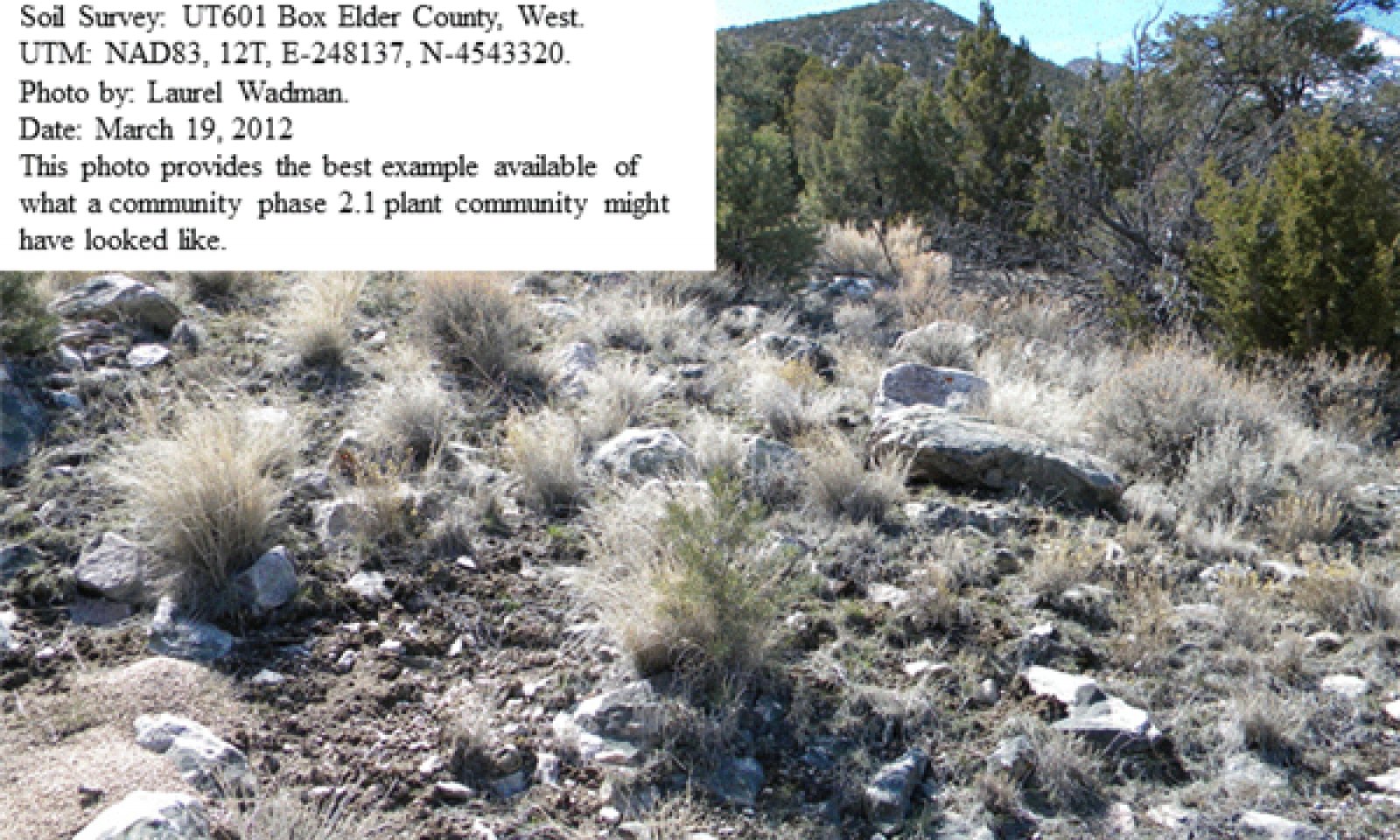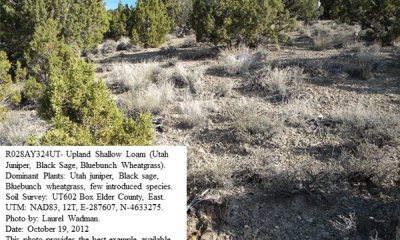
Upland Shallow Loam (Utah Juniper - Singleleaf Pinyon)
Scenario model
Current ecosystem state
Select a state
Management practices/drivers
Select a transition or restoration pathway
- Transition T1A More details
- Transition T1B More details
- Transition T2A More details
- Transition T2B More details
- Restoration pathway R3A More details
- Transition T3A More details
-
No transition or restoration pathway between the selected states has been described
Target ecosystem state
Select a state
Description
The Reference State describes the various biotic communities that are expected to be found on this ecological site under natural conditions. The Reference State has an overstory canopy of Utah juniper with lesser amounts of singleleaf and/or two-needle pinyon. The shrub layer is typically dominated by black sagebrush. A mixture of other shrubs including big sagebrush, antelope bitterbrush, and alderleaf mountain mahogany are commonly found. Bluebunch wheatgrass is the dominant herbaceous species with Nevada bluegrass and Indian ricegrass commonly occurring. Other native grasses, forbs, and shrubs will often produce a significant portion of vegetative composition in the plant community.
The Reference State is self-sustaining and resistant to change due to a good natural resilience to its natural disturbances. The primary natural disturbance mechanisms are wildlife population densities which can affect the shrub layer composition, weather fluctuations, and fire period.
Definitions:
Reference State: Natural plant communities as influenced by tree and shrub canopy densities, long term weather fluctuations, and periodic fire.
Indicators: These communities are dominated by Utah juniper, black sagebrush, and bluebunch wheatgrass. The density of the tree and shrub canopies determines the amount and composition of the other native species present in the community. The composition by air-dry weight is approximately 15 percent trees, 35 percent perennial grasses, 10 percent forbs, and 40 percent shrubs.
Feedbacks: Natural fluctuations in weather patterns that allow for a self-sustaining tree, shrub and native grass community. Prolonged drought, an increase in fire frequency, or other disturbances may allow for the establishment of invasive species.
At-risk Community Phase: All communities are at risk when native plants are stressed and conditions are created that may allow invasive plants to establish.
Trigger: The establishment of invasive plant species.
Characteristics and indicators
This state will have only native species in the plant communities.
Submodel
State 2
Current Potential State




Description
The Current Potential State is similar to the Reference Sate except that non-native species are now present. Ecological function has not changed; however the resiliency of the state has been reduced by the presence of non-native species. These non-natives, particularly cheatgrass, can be highly flammable and promote fire where historically fire had been infrequent. Negative feedbacks enhance ecosystem resilience and contribute to the stability of the state. These include the presence of all structural and functional groups, low fine fuel loads and retention of organic matter and nutrients. Positive feedbacks decrease ecosystem resilience and stability of the state. These include the nonnatives’ high seed output, persistent seed bank, rapid growth rate, ability to cross pollinate, and adaptations for seed dispersal. Fires within this community with the small amount of non-native annual species present are likely still small and patchy due to low fuel loads. This fire type will create a plant community mosaic that will include all/most of the following community phases within this state. The Current Potential State describes the plant communities that may or have become established on this ecological site under various successional sequences and disturbance conditions. This state typically has a well developed overstory canopy composed of Utah juniper with lesser amounts of singleleaf and/or two-needle pinyon. Black sagebrush often dominates the shrub layer. Wyoming big sagebrush, antelope bitterbrush, and alderleaf mountain mahogany are common shrub species. Bluebunch wheatgrass is the dominant herbaceous species with Indian ricegrass, Nevada bluegrass and other perennial grasses and forbs also commonly found in abundance. Cheatgrass, alyssum, various mustard species and other non-native species are present on the site and, under certain circumstances, may visually dominate the sites aspect.
The primary disturbance mechanisms are the tree and shrub layer densities; the amount and kinds of invasive species present; weather fluctuations; and fire. The Current Potential State is still self-sustaining but may be losing its resistance to change due to the impact of disturbances with less resilience following those disturbances.
Definitions:
Current Potential State: Plant communities influenced by tree and shrub canopy density, long term weather fluctuations, and periodic fire. Invasive species are present in various amounts.
Indicators: A community dominated by Utah juniper, black sagebrush and bluebunch wheatgrass. The density of the tree and shrub canopies determines the amount and composition of the other native and introduced grasses and forbs that may be present.
Feedbacks: Natural fluctuations in weather patterns that allow for a self sustaining shrub and native grass community. Prolonged drought, more frequent fires, and/or other disturbances that may allow for the increase of invasive species.
At-risk Community Phase: All communities are at risk when native plants are stressed and nutrients become available for invasive plants to increase.
Trigger: A reduction of perennial grass and forb species combined with an increase of invasive plant species.
Characteristics and indicators
This state will have non-native species in the plant community.
Submodel
Description
The Infilled Tree State has one community phase that is characterized by the dominance of Utah juniper and singleleaf pinyon in the overstory. This state is identifiable by 30 to over 50 percent cover of Utah juniper and singleleaf pinyon. This stand exhibits a mixed age class. Older trees are at maximal height and upper crowns may be flat-topped or rounded. Younger trees are typically cone- or pyramidal shaped. Understory vegetation is sparse due to increasing shade and competition from trees.
Submodel
Description
The Annual State occurs when a recent crown fire has removed most of the Utah juniper and any pinyon trees present from the site. Black sagebrush and other fire sensitive species have also been removed or significantly reduced. The site has a herbaceous aspect with both native and non-native grass and forb species present. Fire resistant shrubs are typically recovering and are increasing in the communities associated with this state. The herbaceous vegetation communities associated with this state can be highly variable depending on the before fire conditions. Typically however, bluebunch wheatgrass is the dominant herbaceous species with Indian ricegrass, Nevada bluegrass, and other perennial grasses and forbs commonly found. Cheatgrass, alyssum, various mustard species, and other non-native species are often present on the site and, under certain circumstances, may visually dominate the sites aspect.
The primary disturbance mechanisms intensity of the fire; the amount and kinds of native and non-native species present; weather fluctuations; and time since the fire occurred. This state may be losing self-sustainability or may be increasing its resistance to degradation due to the impact of fire and the before fire conditions.
Definitions:
Annual: Plant communities influenced by recent crown fire and its impact on the tree and shrub canopy density, long term weather fluctuations, time since the fire occurred. Invasive species are present in various amounts.
Indicators: A community dominated by herbaceous species. The kind and amounts of native and introduced grasses and forbs that may be present.
Feedbacks: Natural fluctuations in weather patterns that allow for a self sustaining shrub and native grass community to develop. Prolonged drought, more frequent fires, and/or other disturbances that may allow for the increase of invasive species.
At-risk Community Phase: All communities are at risk when native plants are stressed and nutrients become available for invasive plants to increase. Annual grasses and forbs that may shorten the sites fire period.
Trigger: A reduction of perennial grass and forb species combined with an increase of invasive plant species.
Submodel
Mechanism
This transitional pathway occurs when any combination of improper livestock grazing, prolonged drought or other disturbance causes the perennial herbaceous community to become significantly reduced allowing non-native species such as cheatgrass, alyssum, Russian thistle and other invasive weeds to become established. Broom snakeweed may also increase during this time. Once invasive species occupy the site, a threshold has been crossed. Cheatgrass, however, has been known to become established in healthy communities on this site.
Trigger: Introduction of non-native annual species
Slow variables: Over time the annual non-native plants will increase within the community.
Threshold: Any amount of introduced non-native species causes an immediate decrease in the resilience of the site. Annual non-native species cannot be easily removed from the system and have the potential to significantly alter disturbance regimes from their historic range of variation.
Mechanism
Trigger: Time and a lack of disturbance allow trees to dominate site resources; may be coupled with inappropriate grazing management that favors shrub and tree dominance.
Slow variables: Over time the abundance and size of trees will increase.
Threshold: Juniper and pinyon canopy cover is greater than 30 percent. Little understory vegetation remains due to competition with trees for site resources.
Mechanism
Trigger: Catastrophic crown fire facilitates the establishment of non-native, annual weeds.
Slow variables: Increase in tree crown cover, loss of perennial understory and an increase in annual non-native species.
Threshold: Cheatgrass or other non-native annuals dominate understory. Loss of deep-rooted perennial bunchgrasses changes spatial and temporal nutrient cycling and nutrient redistribution, and reduces soil organic matter. Increased canopy cover of trees allows severe stand-replacing fire. The increased seed bank of non-native, annual species responds positively to post-fire conditions facilitating the transition to an Annual State.
Mechanism
This transitional pathway occurs when a major fire removes nearly all the Utah juniper and any pinyon present from the site. A combination of improper livestock grazing, prolonged drought, or other disturbance can slow the expected recovery of the perennial herbaceous community, allowing non-native species such as cheatgrass, alyssum, Russian thistle, and other invasive weeds to flourish. Broom snakeweed may also increase during this time. Fire tolerant shrubs will often recover quickly during these periods.
Mechanism
Manual or mechanical thinning of trees coupled with seeding. Probability of success is highest from early on in community phase 3.1 before the understory is depleted.
Mechanism
Trigger: Fire reduces the tree overstory and allows for the annual non-native species in the understory to dominate the site. Soil disturbing treatments such as slash and burn may also reduce tree canopy and allow for non-native annual species to increase.
Slow variables: Over time, cover and production of annual non-native species increases.
Threshold: Loss of deep-rooted perennial bunchgrasses and shrubs changes temporal and spatial nutrient capture and cycling within the community. Increased, continuous fine fuels modify the fire regime by increasing frequency, size, and spatial variability of fires.
Model keys
Briefcase
Add ecological sites and Major Land Resource Areas to your briefcase by clicking on the briefcase (![]() ) icon wherever it occurs. Drag and drop items to reorder. Cookies are used to store briefcase items between browsing sessions. Because of this, the number of items that can be added to your briefcase is limited, and briefcase items added on one device and browser cannot be accessed from another device or browser. Users who do not wish to place cookies on their devices should not use the briefcase tool. Briefcase cookies serve no other purpose than described here and are deleted whenever browsing history is cleared.
) icon wherever it occurs. Drag and drop items to reorder. Cookies are used to store briefcase items between browsing sessions. Because of this, the number of items that can be added to your briefcase is limited, and briefcase items added on one device and browser cannot be accessed from another device or browser. Users who do not wish to place cookies on their devices should not use the briefcase tool. Briefcase cookies serve no other purpose than described here and are deleted whenever browsing history is cleared.
Ecological sites
Major Land Resource Areas
The Ecosystem Dynamics Interpretive Tool is an information system framework developed by the USDA-ARS Jornada Experimental Range, USDA Natural Resources Conservation Service, and New Mexico State University.







